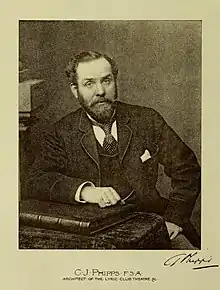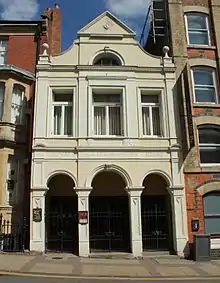C. J. Phipps
Charles John Phipps FSA (25 March 1835 – 25 May 1897) was an English architect known for more than 50 theatres he designed in the latter half of the 19th century, including several important ones in London. He is noted for his design of the Theatre Royal, Exeter, which caught fire in 1887, killing 186 visitors.
C. J. Phipps | |
|---|---|
 Phipps, c. 1890 | |
| Born | 25 March 1835 |
| Died | 25 May 1897 (aged 62) London, England |
| Occupation | Architect |
| Known for | Savoy Theatre, Gaiety Theatre |
| Spouse |
Honor Hicks (m. 1860) |
Biography
Born in Bath, Phipps married Honnor Hicks on 10 April 1860. The couple had two sons and three daughters.[1]
Phipps's first major work was the rebuilding of Theatre Royal, Bath in 1862/3, after the old theatre had been destroyed by fire. Moving to London, he quickly established himself as the leading theatrical architect, building, in rapid succession, the Queen's Theatre (1867), the Gaiety Theatre (1868), the Olympic Theatre (1870) and the Vaudeville Theatre (1871).[2] His early work, especially the Gaiety, inspired a young Frank Matcham, who was impressed at Phipps's ability to build a normal-sized theatre on a small, awkward plot.[3]
Phipps designed the Gaiety Theatre, Dublin for John and Michael Gunn, opened in November 1871.[4] Phipps's Savoy Theatre (1881), a state-of-the-art facility, was the first public building in the world lit entirely by electric light.[2] Other major London theatres included the Strand (1882), the Prince's (1884), the Lyric (1888), the original Shaftesbury Theatre (1888), the Garrick (1889), the Tivoli (1890), Daly's (1893) and Her Majesty's Theatre (1897).
In addition to Phipps's London theatres, he was responsible for over forty theatres in the provinces. He also designed Leinster Hall in Dublin for Michael Gunn (opened in 1886 and closed in 1895), the Star and Garter Hotel at Richmond (demolished in 1919) and the Savoy Turkish Bath. Phipps was chosen to design the Royal Institute of British Architects’ own premises at 9 Conduit Street. The building is still there, though no longer occupied by the RIBA (now in Portland Place) and is considered by some to reflect the influence of the architect's native town. He was a fellow (1866) of the Royal Institute of British Architects, serving on its council in 1875–6, and also of the Society of Antiquaries.[1]

Phipps died on 25 May 1897, aged 62, and is buried in a family grave on the east side of Highgate Cemetery.
Blame for deaths at Exeter fire
Phipps designed the Theatre Royal, Exeter, which opened in 1886.[5][6] In 1887, during a performance, a gauze curtain caught fire from a gas lamp lighting the stage. The resulting fire claimed the lives of 186 visitors and remains the worst theatre-related disaster, and third most deadly fire in UK history.[7] There were two inquiries into the disaster, both of which placed significant blame on Phipps:
A coroner's inquest was opened on 21 September 1887 before a coroner's jury. The magistrates who issued the premises licence had noted only a single exit from the gallery (where the majority of the deaths occurred) where there should have been two, but Phipps persuaded them that people climbing the railing at the front of the balcony and dropping to the Upper Circle below was a suitable and effective second exit. The verdict was of accidental death, but the coroner's jury found that the magistrates had been misled by Phipps and suggested that a licence should never have been issued.[7] The coroner's jury noted that a safety curtain and fire hydrant were specified in the theatre's plans, but had not yet been installed in the building. They also criticised the lack of ceiling height above the gallery, which gave people less time to escape before being overcome by smoke.[7]
A separate parliamentary inquiry was carried out by Captain Eyre Massey Shaw, the Chief Officer of the Metropolitan Fire Brigade. Shaw's report was also critical of Phipps and his design. Phipps attended the inquest and was "vigorous" and "sarcastic" in his defence of his work, pointing out that a number of elements in his plans had been changed or ignored during construction. The jury in this case also returned a verdict of accidental death. Ultimately, Shaw was able to use the results of the fire to bring about stricter theatre regulations, including the requirement for a safety curtain.[8]
Theatres
Among the theatres Phipps designed, or co-designed, are:
- Theatre Royal, Bath (1862/3)
- Theatre Royal, Nottingham (1865)
- Theatre Royal, Brighton (1866)
- Queen's Theatre, Long Acre (1867)
- Prince's Theatre, Bristol (1867)
- Gaiety Theatre, London (1868)
- Olympic Theatre (1870)
- Varieties Music Hall, Hoxton (1870), demolished c. 1980
- Vaudeville Theatre, London (1871)
- Gaiety Theatre, Dublin (1871)
- Tivoli Theatre, Aberdeen (1872)
- Sadler's Wells Theatre, London (1879, completely rebuilt in 1931)
- Theatre Royal, Glasgow (1880 and 1895), the largest surviving example of his work
- Theatre Royal, Belfast (1881), demolished 1961
- Savoy Theatre, London (1881),[9] rebuilt 1929
- Royal Strand Theatre (1882) demolished 1905[10]
- Royal Lyceum Theatre, Edinburgh (1883)
- Royal Hippodrome Theatre (originally Theatre Royal and Opera House), Eastbourne (1883)
- Prince's Theatre, London (1884) also known as the Prince of Wales Theatre; demolished 1934[11]
- Royal Theatre, Northampton (1884)
- Theatre Royal, Portsmouth (1884)
- Theatre Royal, Exeter (1886)
- Lyric Theatre, London (1888)
- Original Shaftesbury Theatre (1888)
- Garrick Theatre, London, with Walter Emden (1889)
- Tivoli Theatre of Varieties, London (1890), demolished 1957
- Queen's Hall (1893), preliminary designs only, bombed in 1941
- Daly's Theatre (1893), demolished
- Grand Theatre, Wolverhampton (1894)
- Toole's Theatre (1895), never built
- Her Majesty's Theatre, London (1897)
Gallery of architectural work
 Her Majesty's Theatre, London (1897)
Her Majesty's Theatre, London (1897) Royal Theatre, Northampton
Royal Theatre, Northampton
References
- Waterhouse 1901.
- Burgess, Michael. "Richard D'Oyly Carte", The Savoyard, January 1975, pp. 7–11
- Garlick, Gorel. "Growing Up On The English Riviera"; Wilmore, p. 42
- Kerins, Des (2009), The Gaiety Theatre, South King Street, Dublin, www.arthurlloyd.co.uk, retrieved 27 July 2020
- Theatre Notebook. Society for Theatre Research. 1971. p. 153.
- "Opening of the New Theatre Royal, Exeter". The Stage. 15 October 1886.
- Gillan, Don (2010). "The Fire at the Theatre Royal, Exeter". Stage Beauty.
- "Exeter Theatre Fire". BBC News. 9 June 2003.
- "C.J. Phipps, architect of the theatre". The Savoyard. 20 (2): 7. September 1981.
- Earl and Sell (2000) pp. 250
- Earl and Sell (2000) pp. 133
- Attribution
![]() This article incorporates text from a publication now in the public domain: Waterhouse, Paul (1901). "Phipps, Charles John". In Lee, Sidney (ed.). Dictionary of National Biography (1st supplement). London: Smith, Elder & Co.
This article incorporates text from a publication now in the public domain: Waterhouse, Paul (1901). "Phipps, Charles John". In Lee, Sidney (ed.). Dictionary of National Biography (1st supplement). London: Smith, Elder & Co.